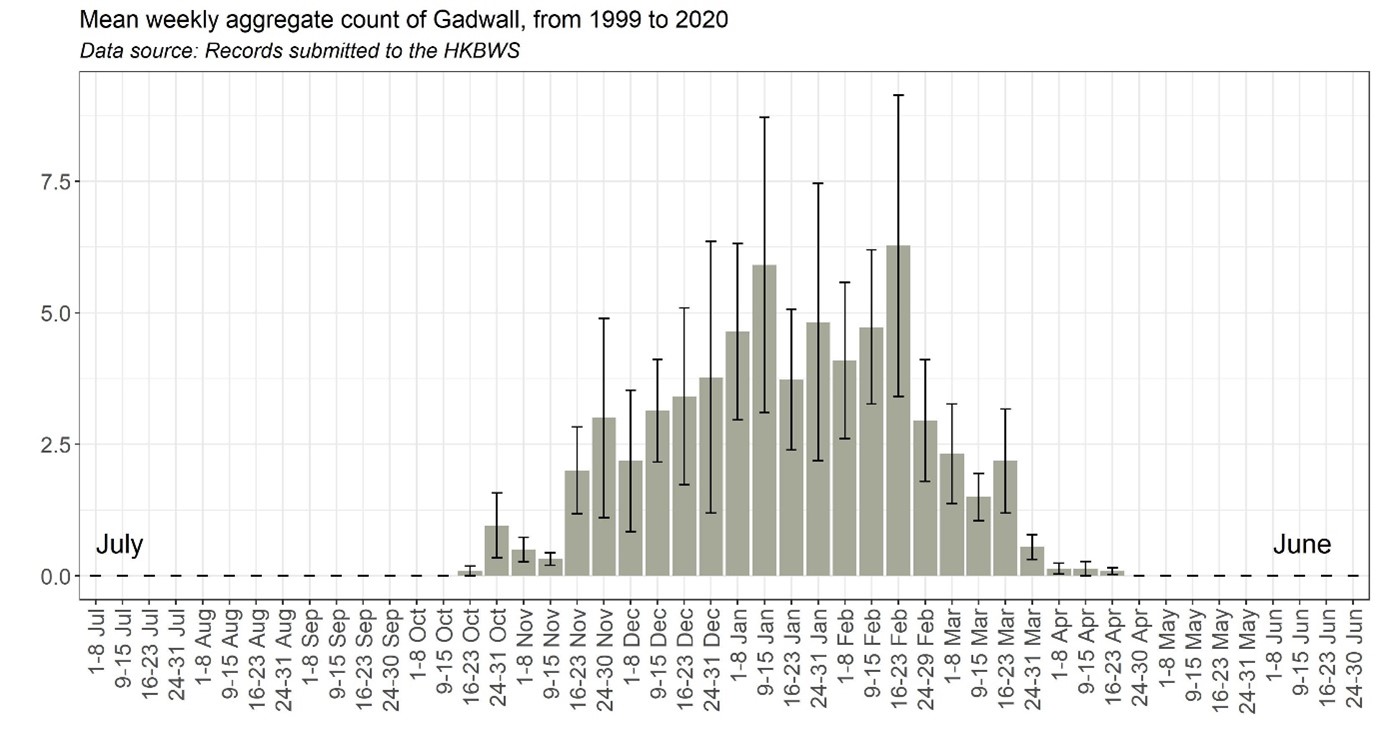Gadwall Mareca strepera 赤膀鴨
Category I. Scarce winter visitor that has declined this century.
IDENTIFICATION

Mar. 2017, Michelle and Peter Wong. Male.
46-56 cm. Overall, rather subdued in its plumage tones. The main feature is a white speculum, though this is usually prominent only in adult male and barely visible on juvenile female. Male has vermiculated greyish chest and flanks, greyish scapulars and black rear end; the head is rather plain, and the bill is dark grey. In flight shows chestnut, black and white on the inner wing.

Mar. 2017, Michelle and Peter Wong. Female.
The female has broad orange sides to the bill with a dark central ridge but otherwise is rather featureless. It has a greyish head, brown body and upperparts that are fringed pale brown and whitish belly.
In flight shows white inner secondaries contrasting with darker outer secondaries and innermost secondary coverts.
VOCALISATIONS
The male utters a short, hard croak.
The female utters a Mallard-like quacking.
DISTRIBUTION & HABITAT PREFERENCE
The majority of records are from the freshwater ponds and brackish gei wai of Mai Po NR. Gadwall very rarely occur in the intertidal areas of Inner Deep Bay, from where it has only been recorded twice. The only northwest New Territories records away from the immediate Deep Bay hinterland occurred at Kam Tin (twice) and Long Valley; the only records away from the northwest New Territories are one at Plover Cove Reservoir on 27 November 1988 and a female at Luk Keng on 28 December 1989.
OCCURRENCE
Gadwall is a winter visitor mainly from the first week of November to the last week of March (Figure 1). Extreme dates are 18 October 2010 and 6 May 1994, though the latest record this century only occurred on 17 April. Most birds seem to arrive rather late in the winter, as many of the highest counts occur after the turn of the year.
The highest is 42 on 12 January 1986, and 40 were recorded later in the same winter on 1 March; the highest count this century, however, is 30 on 1 February 2006. It is apparent from Figure 2, which charts counts made in systematic waterbird counts, that the peak winter count of Gadwall has declined significantly since the turn of the century, and in some winter periods it has not been recorded (other counts in these years have recorded from nil to two birds). Given that HK lies at the southern edge of its Asian wintering range, it is possible that milder winters resulting from climate heating allow more birds to remain north of here.
The first record of Gadwall in Hong Kong was of a bird shot on 28 November 1965. Prior to the mid-1970s difficulties in identification, particularly of females, probably meant it was under-recorded. Thus, higher counts during the 1980s and 1990s were probably due to increased observer familiarity with the species and activity in the field.
BEHAVIOUR, FORAGING & DIET
An unobtrusive duck in terms of both behaviour and appearance. Usually forages by upending to take prey from below the water surface.
RANGE & SYSTEMATICS
The nominate form occurs throughout the Holarctic breeding mainly between 40o N and 60o N in central North America and eastern Europe east through Russia and Kazakhstan to northeast China and Ussuriland. Winters to the south in southern North America and northern Central America, western Europe, north and northeast Africa, the Middle East, northern parts of the Indian subcontinent and south China (Leschack et al. 2020). In China breeds in northern Xinjiang and winters in southern Tibet and much of the area south of a line from Yunnan to Hebei (Liu and Chen 2021).
CONSERVATION STATUS
IUCN: Least Concern. Population trend increasing.
Figure 1.

Figure 2.

Leschack, C. R., S. K. McKnight, and G. R. Hepp (2020). Gadwall (Mareca strepera), version 1.0. In Birds of the World (S. M. Billerman, Editor). Cornell Lab of Ornithology, Ithaca, NY, USA. https://doi.org/10.2173/bow.gadwal.01
Liu, Y and S. H. Chen (eds) (2021). The CNG Field Guide to the Birds of China (in Chinese). Hunan Science and Technology Publication House, Changsha.

